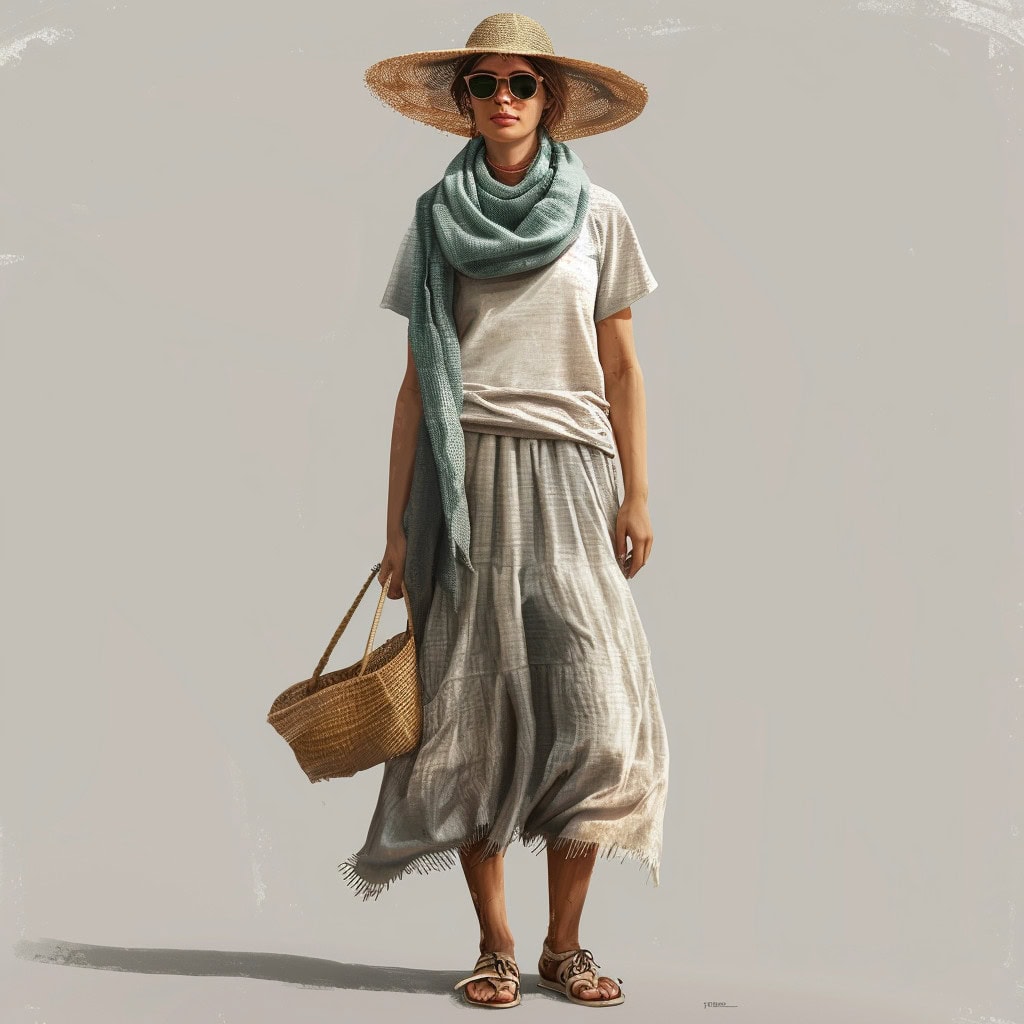As temperatures rise, staying cool and comfortable becomes a top priority. Wearing the right fabric can make a huge difference in how you feel throughout the day. Imagine enjoying a summer breeze without feeling sticky or overheated. This article shows you to the best fabrics for warm weather, explain why they’re ideal for heat, and help you make informed choices for your summer wardrobe.
Quick takes
For a quick and easy outfit to wear during warm weather for a casual outing, I recommend the following:

- Top: A lightweight, breathable cotton t-shirt in a light color to reflect the sun and keep you cool. Look for a relaxed fit to allow for air circulation.
- Bottoms: A linen skirt. Breathable and comfortable, linen is excellent for hot weather.
- Footwear: Comfortable sandals or lightweight canvas sneakers. Sandals keep your feet cool, while canvas sneakers provide a casual yet stylish option.
- Accessories: A wide-brimmed hat or a baseball cap to protect your face from the sun, and a pair of sunglasses to shield your eyes.
- Extras: A lightweight cotton or linen scarf can add a touch of style and can protect your neck from the sun if needed.
This easy outfit looks stylish and keeps you comfortable during your casual warm-weather outings.
Fabric Breakdown
When it comes to dressing for warm weather, choosing the right fabric can make all the difference in staying cool and comfortable. Understanding the characteristics of different fabrics can help you make informed decisions for your summer wardrobe. In this section, we break down popular fabrics, exploring why each fabric makes a good choice for hot weather. While we’re at it, we’ll mention how it’s made and the best way to take care of clothing made with the fabric. Nothing is perfect, so we’ll mention a few downsides each fabric brings with it.
Cotton
- Why It’s Good for Warm Weather: Cotton is incredibly breathable and excellent at absorbing moisture, which helps keep you cool and dry. Its natural fibers allow air to circulate freely, which is essential for maintaining comfort in hot weather.
- How It’s Made: Cotton is harvested from the cotton plant, where the fibers are separated from the seeds. These fibers are then spun into yarn, which is woven or knitted into fabric.
- Sustainability: Conventional cotton farming can be water-intensive and often involves pesticides. However, organic cotton is grown without synthetic chemicals, making it a more sustainable and environmentally friendly option.
- Benefits: Cotton is comfortable, soft, and versatile. It’s easy to dye and can be found in a variety of colors and patterns. It’s also widely available and affordable.
- Downsides: Cotton can shrink if not washed properly, and it tends to wrinkle easily. It can also lose its shape over time with frequent washing.
- Maintenance: Cotton garments are generally machine washable. To prevent shrinking, it’s best to wash in cold water and air dry or use a low heat setting. Ironing may be necessary to smooth out wrinkles.
Linen
- Why It’s Good for Warm Weather: Linen is one of the most breathable fabrics, thanks to its loose weave and natural fibers. It allows heat to escape and air to flow, keeping you cool even in the hottest conditions. It also has excellent moisture-wicking properties.
- How It’s Made: Linen is made from the fibers of the flax plant. The process involves harvesting the flax, extracting the fibers, and then spinning them into yarn, which is woven into fabric.
- Sustainability: Linen is considered eco-friendly because flax requires fewer resources to grow compared to cotton. It uses less water and fewer pesticides, and the entire flax plant can be utilized, reducing waste.
- Benefits: Linen is strong, durable, and gets softer with each wash. It has a natural luster and is resistant to dirt and stains.
- Downsides: Linen wrinkles very easily, which can be a downside for those who prefer a crisp look. It can also feel stiff initially, although it softens with use.
- Maintenance: Linen should be hand or machine washed in cold water. Air drying is recommended to prevent shrinkage, and it’s best to iron linen while it’s still damp to smooth out wrinkles.
Bamboo
- Why It’s Good for Warm Weather: Bamboo fabric is exceptionally soft and breathable. It has natural moisture-wicking properties, which help to keep you dry and comfortable. Bamboo is also known for its temperature-regulating qualities, keeping you cool in the heat.
- How It’s Made: Bamboo fabric is made from the pulp of bamboo plants. The pulp is processed into fibers, which are then spun into yarn and woven into fabric.
- Sustainability: Bamboo is one of the most sustainable plants. It grows rapidly, requires minimal water, and doesn’t need pesticides. However, the chemical process used to turn bamboo into fabric can have environmental impacts, so look for eco-friendly or certified sustainable bamboo products.
- Benefits: Bamboo fabric is hypoallergenic, making it suitable for sensitive skin. It’s also naturally antibacterial and odor-resistant.
- Downsides: Bamboo fabric can be more expensive than other options, and it may require more delicate washing to maintain its softness and durability.
- Maintenance: Hand washing or using a gentle machine wash cycle is recommended. Avoid using fabric softeners, and air drying is best to maintain the fabric’s quality.
Rayon/Viscose
- Why It’s Good for Warm Weather: Rayon, also known as viscose, is lightweight and breathable. It has a smooth texture and drapes well, making it a comfortable and stylish choice for warm weather.
- How It’s Made: Rayon is made from cellulose derived from wood pulp. The cellulose is chemically processed to produce fibers, which are then spun into yarn and woven into fabric.
- Sustainability: The production of rayon involves chemical processing, which can have environmental impacts. However, advancements in production methods are making it more sustainable.
- Benefits: Rayon is soft, smooth, and has a silky feel. It’s also affordable and widely available.
- Downsides: Rayon can be prone to shrinking and wrinkling, and it can be less durable than other fabrics.
- Maintenance: Rayon garments should be hand washed or dry cleaned to avoid damage. If machine washing, use a delicate cycle and cold water. It’s best to air dry rayon to prevent shrinking.
Chambray
- Why It’s Good for Warm Weather: Chambray is a lightweight fabric that looks similar to denim but is much more breathable and suitable for warm weather. It’s made from cotton or linen, making it cool and comfortable to wear.
- How It’s Made: Chambray is typically woven from cotton or linen fibers. It has a plain weave and a slight sheen, giving it a polished appearance.
- Sustainability: Like cotton, chambray can be more sustainable if made from organic cotton or linen. Look for sustainably produced chambray to minimize environmental impact.
- Benefits: Chambray is versatile and can be dressed up or down. It’s comfortable, soft, and easy to wear.
- Downsides: Chambray can fade over time with frequent washing, and it may require ironing to maintain a neat appearance.
- Maintenance: Chambray is generally machine washable. To prevent fading, wash in cold water and air dry. Ironing may be needed to keep it looking crisp.
Silk
- Why It’s Good for Warm Weather: Silk is a natural fiber that’s excellent at regulating temperature, keeping you cool in the summer. It has a luxurious feel and a beautiful drape.
- How It’s Made: Silk is produced by silkworms, which spin cocoons made of silk fibers. These fibers are carefully unwound and spun into yarn, which is then woven into fabric.
- Sustainability: Traditional silk production can have environmental impacts, but organic silk and cruelty-free options are available. Look for sustainably sourced silk to reduce your environmental footprint.
- Benefits: Silk is hypoallergenic and gentle on the skin. It has a natural sheen and a smooth texture that feels wonderful to wear.
- Downsides: Silk requires special care and can be expensive. It’s also prone to water spots and can be damaged by sweat and deodorants.
- Maintenance: Silk garments should be hand washed or dry cleaned. Use a mild detergent and avoid wringing or twisting the fabric. Air dry and iron on a low setting if needed.
Girl Friday says…

I love a loose, long-sleeved linen shirt when I’m out working the farmer’s market. The long sleeves protect a lot of me from the sun, and because linen is so breathable I stay reasonably cool and sweat evaporates instead of drenching the shirt. I’ll wear denim jeans if I’m getting some outside work done, but usually wear a linen or denim skirt in a more casual setting or when working indoors.
Let’s wrap it up
Choosing the right fabric for warm weather can make all the difference in your comfort and style. Experiment with different materials to find what works best for you. Stay cool, stay comfortable, and enjoy the summer!


Leave a Reply